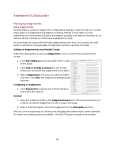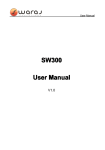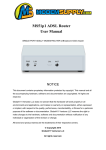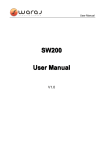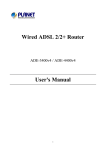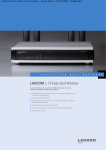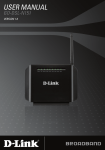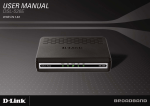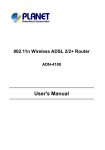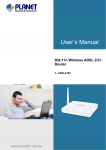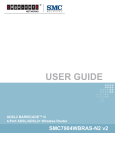Download MSW300Np4 ADSL2+ Modem Router User Manual
Transcript
MSW300Np4 ADSL2+ Modem Router User Manual 4-PORT ADSL2+ MODEM ROUTER w/Realtek rtl8676chipset NOTICE This document contains proprietary information protected by copyright. This manual and all the accompanying hardware, software and documentation are copyrighted. All rights are reserved. Global411 Ventures LLC does not warrant that the hardware will work properly in all environments and applications, and makes no warranty or representation, either expressed or implied, with respect to the quality, performance, merchantability, or fitness for a particular purpose of the software or documentation. Global411 Ventures LLC reserves the right to make changes to the hardware, software and documentation without notification of any individual or organization of the revision or change. All brand and product names are the trademarks of their respective owners. © Copyright 2014 Global411 Ventures LLC All rights reserved. Introduction The MSW300N51P4 is an ADSL2+ access device that supports multiple line modes. The device provides high-speed ADSL2+ broadband connection to the Internet or Intranet for high-end users. downlink up to 24 Mbps and uplink up to 1 Mbps. The device supports WLAN access. It can connect to the Internet through a WLAN AP or WLAN device. It complies with IEEE 802.11, 802.11b/g/n specifications, WEP, WPA, and WPA2 security specifications. Packing List 1 x MSW300Np4 1 x external splitter 1 x power adapter 1 x telephone cables (RJ11) 1 x Ethernet cable (RJ45) Safety Precautions Follow the following instructions to prevent the device from risks and damage caused by fire or electric power: Use the power adapter packed within the device package. Pay attention to the power load of the outlet or prolonged lines. An overburden power outlet or damaged lines and plugs may cause electric shock or fire accident. Check the power cords regularly. If you find any damage, replace it at once. Proper space left for heat dissipation is necessary to avoid damage caused by overheating to the device. The long and thin holes on the device are designed for heat dissipation to ensure that the device works normally. Do not cover these heat dissipation holes. Do not put this device close to a place where a heat source exists or high temperature occurs. Avoid the device from direct sunshine. Do not put this device close to a place where it is over damp or watery. Do not spill any fluid on this device. Do not connect this device to any external power source because any wrong connection may cause power or fire risk. Do not place this device on an unstable surface or support. System Requirements Recommended system requirements are as follows: A 10/100 base-T Ethernet card is installed on your PC A hub or Switch. (connected to several PCs through one of Ethernet interfaces on the device) Operating system: Windows 98SE, Windows 2000, Windows ME, Windows XP Internet Explorer V8.0 or higher or Netscape / Firefox equivalent Subscription for ADSL service. Your ADSL service provider should provide you with at least one valid IP address (static assignment or dynamic). One or more computers, each containing an Ethernet 10/100M Base-T network interface card (NIC). A hub or switch, if you are connecting the device to more than one (1) computer. Features 1 Realtek rtl8676 The device supports the following features: Various line modes External PPPoE dial-up access Internal PPPoE/PPPoA dial-up access 1483Briged/1483Routed/MER/IPoA access Multiple PVCs (up to eight) and these PVCs can be isolated from each other A single PVC with multiple sessions Multiple PVCs with multiple sessions 802.1Q and 802.1P protocol DHCP server NAPT Static route Firmware upgrading through Web, TFTP, or FTP Resetting to the factory defaults through Reset button or Web DNS Virtual server DMZ Two-level passwords and usernames Web interface Telnet CLI System status display PPP session PAP/CHAP IP filter IP quality of service (QoS) Remote access control Line connection status test Remote managing through Telnet or HTTP Backup and restoration of configuration file Ethernet interface supporting crossover detection, auto-correction, and polarity correction Universal plug and play (UPnP) Operating Systems All versions of Windows, Mac and Linux ATM Capabilities All ATM Connection VPI Range: 0-255 VCI Range: 32-65535 AESA (E.164, DCC, ICD) PVC Support, UNI 3.0 & 3.1 Signaling Support AAL 5 Management Support Web Based GUI 192.168.1.1 Upgrade or update via FTP/HTTP Command Line Interface via Telnet Diagnostic Test Firmware upgradeable Factory Defaults IP Address: 192.168.1.1 Subnet Mask: 255.255.255.0 Encapsulation: RFC 1483 LLC VPI/VCI: 0/35 MER Bridge mode Environmental Operating humidity: 10%-90% non-condensing Non-operating storage humidity: 5%-95% non-condensing 2 Hardware Installation Front Panel Step 1 Connect the DSL interface of the device and the Modem interface of the splitter through a telephone cable. Connect the phone to the Phone interface of the splitter through a cable. Connect the incoming line to the Line interface of the splitter. LED Color PWR Green Function On: Power Off: No power or system boot failed On: ADSL link established and active DSL Green Blinking: ADSL is trying to establish a connection Off: No ADSL link ACT Green LAN Green Blinking: ADSL data activity occurs. Off: No ADSL data is being sent or received. On: LAN link established and active Blinking: ADSL data activity occurs. Off: No LAN link. The splitter has three interfaces: Line: Connect to a wall phone jack (RJ-11 jack). Modem: Connect to the ADSL jack of the device. Phone: Connect to a telephone set. 3 Step 2 Connect the LAN interface of the device to the network card of the PC through an Ethernet cable (MDI/MDIX). Note: Use twisted-pair cables to connect with the hub or switch. Step 3 Plug one end of the power adapter to the wall outlet and connect the other end to the Power interface of the device. Installing a telephone directly before the splitter may lead to failure of connection between the device and the central office, or failure of Internet access, or slow connection speed. If you really need to add a telephone set before the splitter, you must add a microfilter before a telephone set. Do not connect several telephones before the splitter or connect several telephones with the microfilter. Port DSL LAN Function Connects the device to an ADSL telephone jack or splitter using a RJ-11 telephone cable Connects the device to your PC's Ethernet port, or to the uplink port on your hub/switch, using a RJ-45 cable Reset System reset or reset to factory defaults. POWER Connects to the supplied power adapter Switches the unit on and off 4 Note: Without the splitter, transient noise from the telephone can interfere with the operation of the ADSL router. As a result, the ADSL router may introduce noise to the telephone line. To prevent this from happening, a small external splitter must be connected to each telephone. Web Configuration This chapter describes how to configure the router by using the Web-based configuration utility. Access the Router The following is the detailed description of accesing the router for the first time. Step 4 Open the Internet Explorer (IE) browser and enter http://192.168.1.1. Step 5 In the Login page that is displayed, enter the username and password. The username and password of the super user are admin and admin. The username and password of the common user are user and user. If you log in as a super user, the page shown in the following figure appears. You can check, configure and modify all the settings. If you log in as a common user, you can check the status of the router, but can not configure the most of the settings. Note: In the Web configuration page, you can click Apply Changes to save the settings temporarily. If you want to save the settings of this page permanently, click save of Attention that appears at the bottom of the Web page after the configuration. 5 Status In the navigation bar, choose Status. In the Status page that is displayed contains: System, LAN, WLAN, WAN, Port Mapping, Statistics and ARP Table. System Choose Status > System. The page that is displayed shows the current status and some basic settings of the router, such as software version, DSP version, uptime, upstream speed and downstream speed. LAN Choose Status > LAN. The page that is displayed shows some basic LAN settings of the router. In this page, you can view the LAN IP address, DHCP server status, MAC address and DHCP client table. If you want to configure the LAN network, refer to chapter 0 LAN IP. 6 WLAN Choose Status > WLAN. The page that is displayed shows some basic settings of wireless LAN (WLAN). WAN Choose Status > WAN. The page that is displayed shows some basic WAN settings of the router. In this page, you can view basic status of WAN and DNS server. If you want to configure the WAN network, refer to chapter 0 WAN. 7 Port Mapping Choose Status > Port Mapping. In this page, you can view the mapping relation and the status of port mapping. Statistics Choose Status > Statistics. The Statistics page that is displayed contains Traffic Statistic and ADSL Statistic. Traffic Statistic Click Traffic Statistic in the left pane. The page shown in the following figure appears. In this page, you can view the statistics of each network port. 8 ADSL Statistic Click ADSL Statistic in the left pane. The page shown in the following figure appears. In this page, you can view the ADSL line status, upstream rate, downstream rate and other information. ARP Table Choose Status > ARP Table. In the ARP Table page, you can view the table that shows a list of learned MAC addresses. 9 Wizard When subscribing to a broadband service, you should be aware of the method by which you are connected to the Internet. Your physical WAN device can be either PPP, ADSL, or both. The technical information about the properties of your Internet connection is provided by your Internet Service Provider (ISP). For example, your ISP should inform you whether you are connected to the Internet using a static or dynamic IP address, and the protocol that you use to communicate on the Internet. The Wizard page guides fast and accurate configuration of the Internet connection and other important parameters. The following sections describe these various configuration parameters. Whether you configure these parameters or use the default ones, click NEXT to enable your Internet connection. In the navigation bar, choose Wizard. The page shown in the following figure appears. The following table describes the parameters in this page: Field Description VPI Virtual path identifier (VPI) is the virtual path between two points in an ATM network. Its valid value is in the range of 0 to 255. Enter the correct VPI provided by your ISP. By default, VPI is set to 0. VCI Virtual channel identifier (VCI) is the virtual channel between two points in an ATM network. Its valid value is in the range of 32 to 65535. (0 to 31 is reserved for local management of ATM traffic) Enter the correct VCI provided by your ISP. By default, VCI is set to 35. After setting, click Next, the page as shown in the following figure appears. There are five WAN connection types: PPP over ATM (PPPoA), PPP over Ethernet (PPPoE), 1483 MER, 1483 Routed and 1483 Bridged. The following describes them respectively. PPPoE/PPPoA In the Connection Type page, set the WAN connection type to PPP over Ethernet (PPPoE), the encapsulation mode to LLC/SNAP. 10 The following table describes the parameters in this page: Field Description WAN Connection Type There are five WAN connection types: PPP over ATM (PPPoA), PPP over Ethernet (PPPoE), 1483 MER, 1483 Routed, and 1483 Bridged. In this example, the connection type is set to PPPoE. Encapsulation Mode You can select LLC/SNAP or VC-Mux. In this example, the encapsulation mode is set to LLC/SNAP. After setting, click Next, the page as shown in the following figure appears. The following table describes the parameters in this page: Field Description Obtain an IP address automatically Select it, the DHCP assigns the IP address for PPPoE connection. Use the following IP address Select it, you need to enter the IP address for PPPoE connection, which is provided by your ISP. Enable NAT Select the checkbox to enable network address translation (NAT). If you do not select it and you want to access the Internet normally, you must add a route on the uplink equipment. Otherwise, the access to the Internet fails. Normally, it is required to enable NAT. After setting, click Next, the page as shown in the following figure appears. The following table describes the parameters in this page: Field Description PPP Username Enter the username for PPPoE dial-up, which is provided by your ISP. PPP Password Enter the password for PPPoE dial-up, which is provided by your ISP. PPP Connection Type You can select Continuous, Connect on Demand, or Manual. 11 Field Description Continuous: After dial-up is successful, PPPoE connection is always on-line, no matter whether the data is being transmitted or not. It is recommended to select it. Connect on Demand: After dial-up is successful, within the preset idle time, no data is being transmitted, the router automatically disconnects the PPPoE connection. In this case, you need to enter the idle time. Manual: Select it, you need to dial up and disconnect the connection mannually. After setting, click Next, the page as shown in the following figure appears. The following table describes the parameters in this page: Field Description LAN Interface Setup LAN IP Enter the IP address of LAN interface. Its valid value is in the range of 192.168.1.1 to 192.168.255.254. The default IP address is 192.168.1.1. LAN Netmask Enter the subnet mask of LAN interface. Its valid value is in the range of 255.255.0.0 to 255.255.255.254. Enable Secondary IP Select the checkbox to enable the secondary LAN IP. The two LAN IP addresses must be in the different network. DHCP Server Enable Server DHCP Select the checkbox to enable DHCP server. Start IP Enter the start IP address that the DHCP sever assigns. End IP Enter the end IP address that the DHCP server assigns. Max Lease Time The lease time determines the period that the PCs retain the assigned IP addresses before the IP addresses change. LAN Interface Setup LAN IP Enter the IP address of LAN interface. Its valid value is in the range of 192.168.1.1 to 192.168.255.254. The default IP address is 192.168.1.1. LAN Netmask Enter the subnet mask of LAN interface. Its valid value is in the range of 255.255.0.0 to 255.255.255.254. 12 Field Description Enable Secondary IP Select the checkbox to enable the secondary LAN IP. The two LAN IP addresses must be in the different network. DHCP Server Enable Server Start IP DHCP Select the checkbox to enable DHCP server. Enter the start IP address that the DHCP sever assigns. After setting, click Next, the page as shown in the following figure appears. Click BACK to modify the settings. Click FINISH to save the settings. Click RESET to cancel the settings. Note: If the WAN connection type is set to PPPoA, the parameters of the WAN connection type are the same as that of PPPoE. For the parameters in these pages, refer to the parameter description of PPPoE. 13 1483 MER/1483 Routed In the Connection Type page, set the WAN connection type to 1483 MER, the encapsulation mode to LLC/SNAP. After setting, click Next, the page as shown in the following figure appears. The following table describes the parameters in this page: Field Description Obtain an IP address automatically Select it, DHCP automatically assigns the IP address for WAN connection. Use the following IP address Select it, you need to manually enter the IP address, subnet mask, and default gateway for WAN connection, which are provided by your ISP. Obtain DNS server addresses automatically Select it, DHCP automatically assigns DNS server address. Use the following DNS server addresses Select it, you need to manually enter the primary DNS server address and secondary DNS server address. Enable NAT Select it to enable network address translation (NAT). If you do not select it and you want to access the Internet normally, you must add a route on the uplink equipment. Otherwise, the access to the Internet fails. Normally, it is required to enable NAT. Enable NAT Select it to enable network address translation (NAT). If you do not select it and you want to access the Internet normally, you must add a route on the uplink equipment. Otherwise, the access to the Internet fails. Normally, it is required to enable NAT. 14 After setting, click Next, the page as shown in the following figure appears. The following table describes the parameters in this page: Field Description LAN Interface Setup LAN IP Enter the IP address of LAN interface. Its valid value is in the range of 192.168.1.1 to 192.168.255.254. The default IP address is 192.168.1.1. LAN Netmask Enter the subnet mask of LAN interface. Its valid value is in the range of 255.255.0.0 to 255.255.255.254. Enable Secondary IP Select the checkbox to enable the secondary LAN IP. The two LAN IP addresses must be in the different network. DHCP Server Enable Server DHCP Select the checkbox to enable DHCP server. Start IP Enter the start IP address that the DHCP sever assigns. End IP Enter the end IP address that the DHCP server assigns. Max Lease Time The lease time determines the period that the PCs retain the assigned IP addresses before the IP addresses change. After setting, click Next, the page as shown in the following figure appears. 15 Click BACK to modify the settings. Click FINISH to save the settings. Click RESET to cancel the settings. Note: If the WAN connection type is set to 1483 Routed, the parameters of the WAN connection type are the same as that of 1483 MER. For the parameters in these pages, refer to the parameter description of 1483 MER. 16 1483 Bridged In the Connection Type page, set the WAN connection type to 1483 Bridged, the encapsulation mode to LLC/SNAP. After setting, click Next, the page as shown in the following figure appears. The following table describes the parameters in this page: Field Description LAN Interface Setup LAN IP Enter the IP address of LAN interface. Its valid value is in the range of 192.168.1.1 to 192.168.255.254. The default IP address is 192.168.1.1. LAN Netmask Enter the subnet mask of LAN interface. Its valid value is in the range of 255.255.0.0 to 255.255.255.254. Enable Secondary IP Select the checkbox to enable the secondary LAN IP. The two LAN IP addresses must be in the different network. DHCP Server Enable Server DHCP Select the checkbox to enable DHCP server. Start IP Enter the start IP address that the DHCP sever assigns. End IP Enter the end IP address that the DHCP server assigns. Max Lease Time The lease time determines the period that the PCs retain the assigned IP addresses before the IP addresses change. After setting, click Next, the page as shown in the following figure appears. 17 Click BACK to modify the settings. Click FINISH to save the settings. Click RESET to cancel the settings. Note: After you saving the settings in the Wizard page, the PVC in the Wizard page replaces that in the Channel Configuration page. The preset PVCs in the Channel Configuration page do not take effect any more. Network In the navigation bar, click Network. The Network page displayed contains LAN, WAN and WLAN. LAN Choose Network > LAN. The LAN page that is displayed contains LAN IP, DHCP and DHCP Static IP. LAN IP Click LAN IP in the left pane, the page shown in the following figure appears. In this page, you can change IP address of the router. The default IP address is 192.168.1.1, which is the private IP address of the router. 18 The following table describes the parameters of this page: Field Description IP Address Enter the IP address of LAN interface. It is recommended to use an address from a block that is reserved for private use. This address block is 192.168.1.1- 192.168.255.254. Subnet Mask Enter the subnet mask of LAN interface. The range of subnet mask is from 255.255.0.0-255.255.255.254. Secondary IP Select it to enable the secondary LAN IP address. The two LAN IP addresses must be in the different network. LAN Port You can choose the LAN interface you want to configure. Link Speed/Duplex Mode You can select the following modes from the drop-downlist:100Mbps/FullDuplex,100Mbps/Half Duplex,10Mbps/FullDuplex,10Mbps/Half Duplex, Auto Negotiation. MAC Control It is the access control based on MAC address. Select it, and the host whose MAC address is listed in the Current Allowed MAC Address Table can access the modem. Add Address Enter MAC address, and then click it to add a new MAC address. DHCP Dynamic Host Configuration Protocol (DHCP) allows the individual PC to obtain the TCP/IP configuration from the centralized DHCP server. You can configure this router as a DHCP server or disable it. The DHCP server can assign IP address, IP default gateway, and DNS server to DHCP clients. This router can also act as a surrogate DHCP server (DHCP Relay) where it relays IP address assignment from an actual real DHCP server to clients. You can enable or disable DHCP server. Click DHCP in the left pane, the page shown in the following figure appears. 19 The following table describes the parameters of this page: Field Description DHCP Mode If set to DHCP Server, the router can assign IP addresses, IP default gateway and DNS Servers to the host in Windows95, Windows NT and other operation systems that support the DHCP client. IP Pool Range It specifies the first and the last IP address in the IP address pool. The router assigns IP address that is in the IP pool range to the host. Show Client Click it, the Active DHCP Client Table appears. It shows IP addresses assigned to clients. Default Gateway Enter the default gateway of the IP address pool. Max Lease Time The lease time determines the period that the host retains the assigned IP addresses before the IP addresses change. Domain Name Enter the domain name if you know. If you leave this blank, the domain name obtained by DHCP from the ISP is used. You must enter host name (system name) on each individual PC. The domain name can be assigned from the router through the DHCP server. DNS Servers You can configure the DNS server ip addresses for DNS Relay. Set VendorClass IP Range Click it, the Device IP Range Table page appears. You can configure the IP address range based on the device type. Click Show Client in the DHCP Mode page, the page shown in the following figure appears. You can view the IP address assigned to each DHCP client. The following table describes the parameters and buttons in this page: Field Description IP Address It displays the IP address assigned to the DHCP client from the router. MAC Address It displays the MAC address of the DHCP client. Each Ethernet device has a unique MAC address. The MAC address is assigned at the factory and it consists of six pairs of hexadecimal character, for example, 00-A0-C5-00-02-12. Expiry (s) It displays the lease time. The lease time determines the period that the host retains the assigned IP addresses before the IP addresses change. Refresh Click it to refresh this page. Close Click it to close this page. Click Set Vendor Class IP Range in the DHCP Mode page, the page as shown in the following figure appears. In this page, you can configure the IP address range based on the device type. 20 In the DHCP Mode field, choose None. The page shown in the following figure appears. 21 In the DHCP Mode field, choose DHCP Relay. The page shown in the following figure appears. The following table describes the parameters and buttons of this page: Field Description DHCP Mode If set to DHCP Relay, the router acts a surrogate DHCP Server and relays the DHCP requests and reponses between the remote server and the client. Relay Server Enter the DHCP server address provided by your ISP. Apply Changes Click it to save the settings of this page. Reset Click it to refresh this page. DHCP Static IP Click DHCP Static IP in the left pane, the page shown in the following figure appears. You can assign the IP addresses on the LAN to the specific individual PCs based on their MAC address. The following table describes the parameters and buttons of this page: Field Description IP Address Enter the specified IP address in the IP pool range, which is assigned to the host. MAC Address Enter the MAC address of a host on the LAN. Add After entering the IP address and MAC address, click it. A row will be added in the DHCP Static IP Table. Delete Selected Select a row in the DHCP Static IP Table, then click it, this row is deleted. Reset Click it to refresh this page. DHCP Static IP Table It shows the assigned IP address based on the MAC address. 22 WAN Choose Network > WAN. The WAN page that is displayed contains WAN, ATM Setting and ADSL Setting. WAN Click WAN in the left pane, the page shown in the following figure appears. In this page, you can configure WAN interface of your router. The following table describes the parameters of this page: Field Description Default Route Selection You can select Auto or Specified. VPI The virtual path between two points in an ATM network, ranging from 0 to 255. VCI The virtual channel between two points in an ATM network, ranging from 32 to 65535 (1 to 31 are reserved for known protocols) Encapsulation You can choose LLC and VC-Mux. Channel Mode You can choose 1483 Bridged, 1483 MER, PPPoE, PPPoA, 1483 Routed or IPoA. Enable NAPT Select it to enable Network Address Port Translation (NAPT) function. If you do not select it and you want to access the Internet normally, you must add a route on the uplink equipment. Otherwise, the access to the Internet fails. Normally, it is enabled. Enabel IGMP You can enable or disable Internet Group Management Protocol (IGMP) function. PPP Settings User Name Enter the correct user name for PPP dial-up, which is provided by your ISP. Password Enter the correct password for PPP dial-up, which is provided by your ISP. Type You can choose Continuous, Connect on Demand, or Manual. Idle Time (min) If set the type to Connect on Demand, you need to enter the idle timeout time. Within the preset minutes, if the router does not detect the flow of the user continuously, the router automatically disconnects the PPPoE connection. WAN IP Settings Type You can choose Fixed IP or DHCP. If select Fixed IP, you should enter the local IP address, remote IP address and subnet mask. If select DHCP, the router is a DHCP client, the WAN IP address is assigned 23 Field Description by the remote DHCP server. Local IP Address Enter the IP address of WAN interface provided by your ISP. Netmask Enter the subnet mask of the local IP address. Unnumbered Select this checkbox unnumbered function. Add After configuring the parameters of this page, click it to add a new PVC into the Current ATM VC Table. Modify Select a PVC in the Current ATM VC Table, then modify the parameters of this PVC. After finishing, click it to apply the settings of this PVC. Current ATM VC Table This table shows the existed PVCs. It shows the interface name, channel mode, VPI/VCI, encapsulation mode, local IP address, remote IP address and other information. The maximum item of this table is eight. to enable IP Click in the PPPoE mode, the page shown in the following figure appears. In this page, you can configure parameters of this PPPoE PVC. The following table describes the parameters and buttons of this page: Field Description Protocol It displays the protocol type used for this WAN connection. ATM VCC The ATM virtual circuit connection assigned for this PPP interface (VPI/VCI). Login Name The user name provided by your ISP. Password The password provided by your ISP. 24 Field Description Authentication Method You can choose AUTO, CHAP, or PAP. Connection Type You can choose Continuous, Connect on Demand, or Manual. Idle Time (s) If choose Connect on Demand, you need to enter the idle timeout time. Within the preset minutes, if the router does not detect the flow of the user continuously, the router automatically disconnects the PPPoE connection. Bridge You can select Bridged Ethernet, Bridged PPPoE, or Disable Bridge. AC-Name The accessed equipment type. Service-Name The service name. 802.1q You can select Disable or Enable. After enable it, you need to enter the VLAN ID. The value ranges from 1 to 4095. Apply Changes Click it to save the settings of this page temporarily. Return Click it to return to the Channel Configuration page. Reset Click it to refresh this page. Source Mac address The MAC address you want to clone. MAC Clone Click it to enable the MAC Clone function with the MAC address that is configured. ATM Setting Click ATM Setting in the left pane, the page shown in the following figure appears. In this page, you can configure the parameters of the ATM, including QoS, PCR, CDVT, SCR and MBS. The following table describes the parameters of this page: Field Description VPI The virtual path identifier of the ATM PVC. VCI The virtual channel identifier of the ATM PVC. QoS The QoS category of the PVC. You can choose UBR, CBR, rt-VBR, or nrt-VBR. PCR Peak cell rate (PCR) is the maximum rate at which cells can be transmitted along a connection in the ATM network. Its value ranges from 1 to 65535. CDVT Cell delay variation tolerance (CDVT) is the amount of delay permitted between ATM cells (in microseconds). Its value ranges from 0 to 4294967295. SCR Subtain cell rate (SCR) is the maximum rate that traffic can pass over a PVC without the risk of cell loss. Its value ranges from 0 to 65535. MBS Maximum burst size (MBS) is the maximum number of cells that can be transmitted at the PCR. Its value ranges from 0 to 65535. 25 ADSL Setting Click ADSL Setting in the left pane, the page shown in the following figure appears. In this page, you can select the DSL modulation. Mostly, you need to remain this factory default settings. The router supports these modulations: G.Lite, G.Dmt, T1.413, ADSL2, ADSL2+, AnnexL and AnnexM. The router negotiates the modulation modes with the DSLAM. WLAN Basic Setting Choose WLAN > Basic Setting and the following page appears. In this page, you can configure the parameters for wireless LAN clients that may connect to the modem. The following table describes the parameters of this page: Field Description Choose the working mode of the modem. You can choose from drop-down list. Band Mode Choose the network model of the modem, which is varied according to the software. By default, the network model of the modem is AP. SSID The service set identification (SSID) is a unique name to identify the modem in the wireless LAN. Wireless stations associating to the modem must 26 Field Description have the same SSID. Enter a descriptive name that is used when the wireless client connecting to the modem. Channel Number A channel is the radio frequency used by 802.11b/g/n wireless devices. There are 13 channels (from 1 to 13) available depending on the geographical area. You may have a choice of channels (for your region) and you should use a different channel from an adjacent AP to reduce the interference. Interference and degrading performance occurs when radio signal from different APs overlap. Choose a channel from the drop-down list box. Radio Power You can choose the transmission power of the radio signal. The default one is 100%. It is recommended to choose the default value100%. Show Active Clients Click it to view the information of the wireless clients that are connected to the modem. Apply Changes Click it to apply the settings temporarily. If you want to save the settings of this page permanently, click Save in the lower left corner. Security Choose WLAN > Security and the following page appears. The following table describes the parameters of this page: Field Description Encryption Configure the wireless encryption mode. You can choose None, WEP, WPA (TKIP), WPA (AES), WPA2 (AES), WPA2 (TKIP), or WPA2 Mixed. Wired equivalent privacy (WEP) encrypts data frames before transmitting over the wireless network. Wi-Fi protected access (WPA) is a subset of the IEEE802.11i security specification draft. WPA2 Mixed is the collection of WPA and WPA2 encryption modes. The wireless client establishes the connection between the modem through WPA or WPA2. Key differences between WPA and WEP are user authentication and improved data encryption. Set WEP Key It is available when you set the encryption mode to WEP. Click it, the Wireless WEP Key Setup page appears. WPA Authentication Mode Select Personal (Pre-Shared Key), enter the pre-shared key in the Pre-Shared Key field. 27 Field Description Select Enterprise (RADIUS), enter the port, IP address, and password of the Radius server. You need to enter the username and password provided by the Radius server when the wireless client connects the modem. If the encrypton is set to WEP, the modem uses 802.1 X authentication, which is Radius authentication. Click Set WEP Key, and the following page appears. The following describes the parameters of this page: Field Description Key Length Choose the WEP key length. You can Choose 64-bit or 128-bit. Key Format If you choose 64-bit, you can choose ASCII (5 characters) or Hex (10 characters). If you choose 128-bit, you can choose ASCII (13 characters) or Hex (26 characters). Default Tx Key Choose the index of WEP Key. You can choose Key 1, Key 2, Key 3, or Key 4. Encryption Key 1 to 4 The Encryption keys are used to encrypt the data. Both the modem and wireless stations must use the same encryption key for data transmission. If you choose 64-bit and ASCII (5 characters), enter any 5 ASCII characters. If you choose 64-bit and Hex (10 characters), enter any 10 hexadecimal characters. If you choose 128-bit and ASCII (13 characters), enter any 13 ASCII characters. If you choose 128-bit and Hex (26 characters), enter any 26 hexadecimal characters. Apply Changes Click it to apply the settings temporarily. If you want to save the settings of this page permanently, click Save in the lower left corner. 28 The following describes the parameters of this page: Field Description Key Length Choose the WEP key length. You can Choose 64-bit or 128-bit. Key Format If you choose 64-bit, you can choose ASCII (5 characters) or Hex (10 characters). If you choose 128-bit, you can choose ASCII (13 characters) or Hex (26 characters). Default Tx Key Choose the index of WEP Key. You can choose Key 1, Key 2, Key 3, or Key 4. Encryption Key 1 to 4 The Encryption keys are used to encrypt the data. Both the modem and wireless stations must use the same encryption key for data transmission. If you choose 64-bit and ASCII (5 characters), enter any 5 ASCII characters. If you choose 64-bit and Hex (10 characters), enter any 10 hexadecimal characters. If you choose 128-bit and ASCII (13 characters), enter any 13 ASCII characters. If you choose 128-bit and Hex (26 characters), enter any 26 hexadecimal characters. Apply Changes Click it to apply the settings temporarily. If you want to save the settings of this page permanently, click Save in the lower left corner. Advanced Settings Choose WLAN > Advanced Setting and the following page appears. In this page, you can configure the wireless advanced parameters. It is recommended to use the default parameters. Note: The parameters in the Advanced Setting are modified by the professional personnel, it is recommended to keep the default values. 29 The following table describes the parameters of this page: Field Description Authentication Select the modem operating in the open system or encryption authentication. You can choose Open System, Shared Key, or Auto. In the open system, the wireless client can directly connect to the device In the encryption authentication, the wireless client connects to the modem through the shared key. Data Rate Choose the transmission rate of the wireless data. You can choose Auto, 1 M, 2 M, 5.5 M, 11 M, 6 M, 9 M, 12 M, 18 M, 24 M, 36 M, 48 M, 54M, MSC0-MSC15. PreambleType Long Preamble: It means this card always use long preamble. Short Preamble: It means this card can support short preamble capability. Broadcast SSID Select whether the modem broadcasts SSID or not. You can select Enable or Disable. Select Enable, the wireless client searches the modem through broadcasting SSID. Select Disable to hide SSID, the wireless clients can not find the SSID. Relay Blocking Wireless isolation. Select Enable, the wireless clients that are connected to the modem can not intercommunication. Ethernet to Wireless Blocking Whether the wireless network can communicate with the Ethernet network or not. Wifi Multicast to Unicast Enable it to using unicast to transmit multicast packet Aggregation It is applied when the destination end of all MPDU are for one STA. Short GI It is not recommended to enable GI in obvious environment of Multi-path effect. Apply Changes Click it to apply the settings temporarily. If you want to save the settings of this page permanently, click Save in the lower left corner. WPS Choose WLAN > WPS and the following page appears. There are two ways for the wireless client to establish the connection with the modem through WPS. The modem generates PIN, see the above figure. Click Regenerate PIN to generate a new PIN, and then click Start PBC, In the wireless client tool, enter the PIN which is generated by the modem,start connection. The client will automatically establish the connection with the modem through the encryption mode, and you need not to enter the key. The other way is the wireless client generates 30 PIN. In the above figure, enter PIN of the wireless client in the Client PIN Number field, then click Start PIN to establish the connection. Note: The wireless client establishes the connection with the modem through WPS negotiation.The wireless client must support WPS Service In the navigation bar, click Service. In the Service page that is displayed contains DNS, Firewall, UPNP, IGMP Proxy, TR-069 and ACL. DNS Domain Name System (DNS) is an Internet service that translates the domain name into IP address. Because the domain name is alphabetic, it is easier to remember. The Internet, however, is based on IP addresses. Every time you use a domain name, DNS translates the name into the corresponding IP address. For example, the domain name www.example.com might be translated to 198.105.232.4. The DNS has its own network. If one DNS server does not know how to translate a particular domain name, it asks another one, and so on, until the correct IP address is returned. Choose Service > DNS. The DNS page that is displayed contains DNS and DDNS. DNS Click DNS in the left pane, the page shown in the following figure appears. The following table describes the parameters and buttons of this page: Field Description Obtain DNS Automatically Select it, the router accepts the first received DNS assignment from one of the PPPoA, PPPoE or MER enabled PVC(s) during the connection establishment. Set DNS Manually Select it, enter the IP addresses of the primary and secondary DNS server. Apply Changes Click it to save the settings of this page. Reset Click it to start configuring the paremters in this page. 31 DDNS Click DDNS in the left pane, the page shown in the following figure appears. This page is used to configure the dynamic DNS address from DynDNS.org or TZO. You can add or remove to configure dynamic DNS. The following table describes the parameters of this page: Field Description DDNS provider Choose the DDNS provider name. You can choose DynDNS.org or TZO. Host Name The DDNS identifier. Interface The WAN interface of the router. Enable Enable or disable DDNS function. Username The name provided by DDNS provider. Password The password provided by DDNS provider. Email The email provided by DDNS provider. Key The key provided by DDNS provider. Firewall Choose Service > Firewall. The Firewall page that is displayed contains IP/Port Fileter, MAC Filter, URL Blocking, Virtual Server, IP Address Mapping, DMZ Setting, NAT EXCLUDE IP, ALG Setting and Anti-DoS. IP/Port Filter Click IP/Port Filter in the left pane, the page shown in the following figure appears. Entries in the table are used to restrict certain types of data packets through the gateway. These filters are helpful in securing or restricting your local network. 32 MAC Filter Click MAC Filter in the left pane, the page shown in the following figure appears. Entries in the table are used to restrict certain types of data packets from your local network to Internet through the gateway. These filters are helpful in securing or restricting your local network. URL Blocking Click URL Blocking in the left pane, the page shown in the following figure appears. This page is used to block a fully qualified domain name, such as tw.yahoo.comand and filtered keyword. You can add or delete FQDN and filtered keyword. The following table describes the parameters and buttons of this page: Field Description URL Blocking Capability You can choose Disable or Enable. Select Disable to disable URL blocking function and keyword filtering function. Select Enable to block access to the URLs and keywords specified in the URL Blocking Table. Keyword Enter the keyword to block. AddKeyword Click it to add a keyword to the URL Blocking Table. Delete Selected Keyword Select a row in the URL Blocking Table and click it to delete the row. URL Blocking Table A list of the URL (s) to which access is blocked. 33 Virtual Server Click Virtual Server in the left pane, the page shown in the following figure appears. The following table describes the parameters of this page: Field Description Service Type You can select the common service type, for example, AUTH, DNS, or FTP. You can also define a service name. If you select Usual Service Name, the corresponding parameter has the default settings. If you select User-defined Service Name, you need to enter the corresponding parameters. Protocol Choose the transport layer protocol that the service type uses. You can choose TCP or UDP. WAN Setting You can choose Interface or IP Address. WAN Interface Choose the WAN interface that will apply virtual server. WAN Port Choose the access port on the WAN. LAN Open Port Enter the port number of the specified service type. LAN IP Address Enter the IP address of the virtual server. It is in the same network segment with LAN IP address of the router. 34 IP Address Mapping NAT is short for Network Address Translation. The Network Address Translation Settings window allows you to share one WAN IP address for multiple computers on your LAN. Click IP Address Mapping in the left pane, the page shown in the following figure appears. Entries in this table allow you to configure one IP pool for specified source IP address from LAN, so one packet whose source IP is in range of the specified address will select one IP address from the pool for NAT. DMZ Setting Demilitarized Zone (DMZ) is used to provide Internet services without sacrificing unauthorized access to its local private network. Typically, the DMZ host contains devices accessible to Internet traffic, such as web (HTTP) servers, FTP servers, SMTP (e-mail) servers and DNS servers. Click DMZ Setting in the left pane, the page shown in the following figure appears. The following describes how to configure DMZ. Step 6 Select Enable DMZ to enable this function. Step 7 Enter an IP address of the DMZ host. Step 8 Click Apply Changes to save the settings of this page temporarily. 35 NAT EXCLUDE IP Click NAT EXCLUDE IP in the left pane, the page shown in the following figure appears. In the page, you can configure some source IP addresses which use the purge route mode when accessing internet through the specified interface. UPNP Choose Service > UPnP, the page shown in the following figure appears. This page is used to configure UPnP. The system acts as a daemon after you enable it. 36 IGMP Proxy Choose Service > IGMP Proxy, the page shown in the following figure appears. IGMP proxy enables the system to issue IGMP host messages on behalf of hosts that the system discovered through standard IGMP interfaces. The system acts as a proxy for its hosts after you enable it. ACL Choose Service > ACL, the page shown in the following figure appears. In this page, you can permit the data packets from LAN or WAN to access the router. You can configure the IP address for Access Control List (ACL). If ACL is enabled, only the effective IP address in the ACL can access the router. Note: If you select Enable in ACL capability, ensure that your host IP address is in ACL list before it takes effect. 37 The following table describes the parameters and buttons of this page: Field Description Direction Select Select the router interface. You can select LAN or WAN. In this example, LAN is selected. LAN ACL Switch Select it to enable or disable ACL function. IP Address Enter the IP address of the specified interface. Only the IP address that is in the same network segment with the IP address of the specified interface can access the router. Services Allowed You can choose the following services from LAN: Web, Telnet, FTP, TFTP, SNMP, or PING. You can also choose all the services. Add After setting the parameters, click it to add an entry to the Current ACL Table. Reset Click it to refresh this page. Set direction of the data packets to WAN, the page shown in the following figure appears. 38 The following table describes the parameters and buttons of this page: Field Description Direction Select Select the router interface. You can select LAN or WAN. In this example, WAN is selected. WAN Setting You can choose Interface or IP Address. WAN Interface Choose the interface that permits data packets from WAN to access the router. IP Address Enter the IP address on the WAN. Only the IP address that is in the same network segment with the IP address on the WAN can access the router. Services Allowed You can choose the following services from WAN: Web, Telnet, FTP, TFTP, SNMP, or PING. You can also choose all the services. Add After setting the parameters, click it to add an entry to the Current ACL Table. Reset Click it to refresh this page. Advanced In the navigation bar, click Advanced. In the Advanced page that is displayed contains Bridge Setting, Routing, Port Mapping, QoS, SNMP and Others. Bridge Setting Choose Advanced > Bridge Setting, the page shown in the following figure appears. This page is used to configure the bridge parameters. You can change the settings or view some information on the bridge and its attached ports. The following table describes the parameters and button of this page: Field Description Aging Time If the host is idle for 300 seconds (default value), its entry is deleted from the bridge table. 802.1d Spanning Tree You can select Disable or Enable. Select Enable to provide path redundancy while preventing undesirable loops in your network. Show MACs Click it to show a list of the learned MAC addresses for the bridge. Click Show MACs, the page shown in the following figure appears. This table shows a list of learned MAC addresses for this bridge. 39 Routing Choose Advanced > Routing, the page shown in the following figure appears. The page that is displayed contains Static Route and RIP. Static Route Click Static Route in the left pane, the page shown in the following figure appears. This page is used to configure the routing information. You can add or delete IP routes. The following table describes the parameters and buttons of this page: Field Description Enable Select it to use static IP routes. Destination Enter the IP address of the destination device. Subnet Mask Enter the subnet mask of the destination device. Next Hop Enter the IP address of the next hop in the IP route to the destination device. Metric The metric cost for the destination. Interface The interface for the specified route. Add Route Click it to add the new static route to the Static Route Table. Update Select a row in the Static Route Table and modify the parameters. Then click it to save the settings temporarily. Delete Selected Select a row in the Static Route Table and click it to delete the row. Show Routes Click it, the IP Route Table appears. You can view a list of destination routes commonly accessed by your network. Static Route Table A list of the previously configured static IP routes. Click Show Routes, the page shown in the following figure appears. The table shows a list of destination routes commonly accessed by your network. 40 RIP Click RIP in the left pane, the page shown in the following figure appears. If you are using this device as a RIP-enabled router to communicate with others using Routing Information Protocol (RIP), enable RIP. This page is used to select the interfaces on your devices that use RIP, and the version of the protocol used. The following table describes the parameters and buttons of this page: Field Description RIP Select Enable, the router communicates with other RIP-enabled devices. Apply Changes Click it to save the settings of this page. Interface Choose the router interface that uses RIP. Receive Version Choose the interface version that receives RIP messages. You can choose RIP1, RIP2, or Both. Choose RIP1 indicates the router receives RIP v1 messages. Choose RIP2 indicates the router receives RIP v2 messages. Choose Both indicates the router receives RIP v1 and RIP v2 messages. Send Version The working mode for sending RIP messages. You can choose RIP1 or RIP2. Choose RIP1 indicates the router broadcasts RIP1 messages only. Choose RIP2 indicates the router multicasts RIP2 messages only. Add Click it to add the RIP interface to the Rip Configration List. Delete Select a row in the Rip Configration List and click it to delete the row. 41 Port Mapping Choose Advanced > Port Mapping. The page shown in the following figure appears. In this page, you can bind the WAN interface and the LAN interface to the same group. 42 The procedure for manipulating a mapping group is as follows: Step 9 Select Enable to enable this function. Step 10 Select a group from the table. Step 11 Select interfaces from the WAN and LAN interface list and add them to the grouped interface list using the arrow buttons to manipulate the required mapping of the ports. Click Apply Changes to save the changes. QoS Choose Advanced > QoS, the page shown in the following figure appears. Entries in the QoS Rule List are used to assign the precedence for each incoming packet based on physical LAN port, TCP/UDP port number, source IP address, destination IP address and other information. Step 12 Enable IP QoS and click Apply to enable IP QoS function. Step 13 Click add rule to add a new IP QoS rule. The page shown in the following figure appears. 43 44 The following table describes the parameters and buttons of this page: Field Description IP QoS Select to enable or disable IP QoS function. You need to enable IP QoS if you want to configure the parameters of this page. QoS Policy You can choose stream based, 802.1p based, or DSCP based. Schedule Mode You can choose strict prior or WFQ (4:3:2:1). Source IP The IP address of the source data packet. Source Mask The subnet mask of the source IP address. Destination IP The IP address of the destination data packet. Destination Mask The subnet mask of the destination IP address. Source Port The port of the source data packet. Destination Port The port of the destination data packet. Protocol The protocol responds to the IP QoS rules. You can choose TCP, UDP, or ICMP. Physical Port The LAN interface responds to the IP QoS rules. Set priority The priority of the IP QoS rules. P0 is the highest priority and P3 is the lowest. IP Precedence You can choose from 0 to 7 define the priority in the ToS of the IP data packet. IP ToS The type of IP ToS for classifying the data package You can choose Normal Service, Minimize Cost, Maximize Reliability, Maximize Throughput, or Minimize Delay. 802.1p You can choose from 0 to 7. Delete Select a row in the QoS rule list and click it to delete the row. Delete all Select all the rows in the QoS rule list and click it to delete the rows. SNMP Choose Advanced > SNMP, the page shown in the following figure appears. You can configure the SNMP parameters. 45 The following table describes the parameters of this page: Field Description Enable SNMP Select it to enable SNMP function. You need to enable SNMP, and then you can configure the parameters of this page. Trap IP Address Enter the trap IP address. The trap information is sent to the corresponding host. Community Name (Read-only) The network administrators must use this password to read the information of this router. Community Name (Read-Write) The network administrators must use this password to configure the information of the router. Others Choose Advanced > Others, the page shown in the following figure appears. Admin In the navigation bar, click Admin. The Admin page that is displayed contains Commit/Reboot, Upgrade, System Log, Password and Time Zone. Commit/Reboot Choose Admin > Commit/Reboot, the page shown in the following figure appears. You can set the router reset to the default settings or set the router to commit the current settings. 46 The following table describes the parameters and button of this page: Field Description Reboot from You can choose Save the current configuration or Restore to the factory default configuration. Save the current configuration: Save the current settings, and then reboot the router. Restore to the factory default configuration: Reset to the factory default settings, and then reboot the the router. Reboot Click it to reboot the router. Upgrade Choose Admin > Upgrade. The Upgrade page that is displayed contains Upgrade Firmware and Backup/Restore. Caution: Do not turn off the router or press the Reset button while the procedure is in progress. Upgrade Firmware Click Upgrade Firmware in the left pane, the page shown in the following figure appears. In this page, you can upgrade the firmware of the router. The following table describes the parameters and button of this page: Field Description Select File Click Browse to select the firmware file. Upload After selecting the firmware file, click Upload to starting upgrading the firmware file. Reset Click it to starting selecting the firmware file. Backup/Restore Click Backup/Restore in the left pane, the page shown in the following figure appears. You can backup the current settings to a file and restore the settings from the file that was saved previously. 47 The following table describes the parameters and button of this page: Field Description Save Settings to File Click it, and select the path. Then you can save the configuration file of the router. Load Settings from File Click Browse to select the configuration file. Upload After selecting the configuration file of the router, click Upload to start uploading the configuration file of the router. System Log Choose Admin > System Log, the page shown in the following figure appears. In this page, you can enable or disable system log function and view the system log. Password Choose Admin > Password, the page shown in the following figure appears. By default, the user name and password are admin and admin respectively. The common user name and password are user and user respectively. The following table describes the parameters of this page: Field Description User Name Choose the user name for accessing the router. You can choose admin or user. Privilege Choose the privilege for the account. Old Password Enter the old password New Password Enter the password to which you want to change the old password. Confirm Password Enter the new password again. 48 Time Zone Choose Admin > Time Zone, the page shown in the following figure appears. You can configure the system time manually or get the system time from the time server. 49 The following table describes the parameters of this page: Field System Time Description Set the system time manually. NTP Configuration State Select enable or disable NTP function. You need to enable NTP if you want to configure the parameters of NTP. Primary Server Set the primary NTP server manually. Secondary Server Set the secondary NTP server manually. Time Zone Choose the time zone in which area you are from the drop down list. Diagnostic In the navigation bar, click Diagnostic. The Diagnostic page that is displayed contains Ping, ATM Loopback, ADSL and Diagnostic Test. Ping Choose Diagnostic > Ping. The page shown in the following figure appears. The following table describes the parameter and button of this page: Field Description Host Enter the valid IP address or domain name. Run Ping Click it to start to Ping. ATM Loopback Choose Diagnostic > ATM Loopback. The page shown in the following figure appears. In this page, you can use VCC loopback function to check the connectivity of the VCC. The ATM loopback test is useful for troubleshooting problems with the DSLAM and ATM network. Click Run Loopback to start testing. 50 ADSL Choose Diagnostic > ADSL. The page shown in the following figure appears. It is used for ADSL tone diagnostics. Click Start to start ADSL tone diagnostics. Diagnostic Test Choose Diagnostic > Diagnostic Test, the page shown in the following figure appears. In this page, you can test the DSL connection. You can also view the LAN status connection and ADSL connection. Click Run Diagnostic Test to start testing. 51




















































